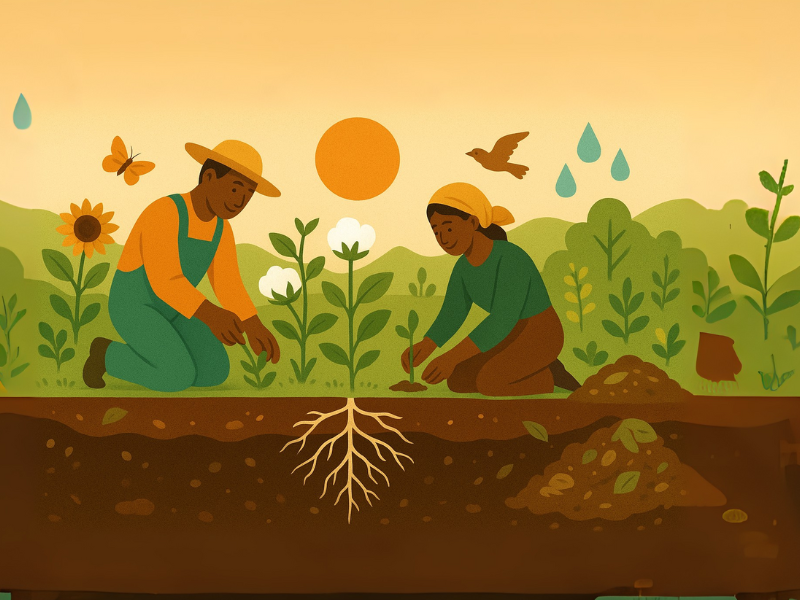Not all cotton is created equal, and what’s in your fabric matters more than ever. As people become more conscious of what they wear and use, organic natural cotton fabric stands out for its clean production, safety, and lower impact on the environment.
While conventional cotton farming relies heavily on chemicals, organic cotton uses non-GMO seed, supports healthy soil, and follows natural cotton growing practices. Globally, cotton covers just 2.5% of agricultural land but uses around 16% of all insecticides, making organic alternatives not only safer but necessary.
In this guide, we’ll explore what organic cotton really is, how the crop is grown and processed, and where the most sustainable sources come from, so you can make better, informed choices in modern life.
Looking to source eco-certified fabrics? Explore Itendee’s sustainable collection.
What Is Organic Cotton?
Organic cotton is a type of cotton grown without the use of toxic pesticides, synthetic fertilizers, genetically modified seeds, or harsh processing chemicals. It starts with non-GMO seed planted in healthy, chemical-free soil, and relies on natural farming practices that protect both the environment and the farmers.

Unlike conventional cotton, organic cotton must meet strict ecological and ethical standards. Certifications like the Global Organic Textile Standard (GOTS) ensure that every step, from the cotton growing process to final fabric production, follows responsible methods.
It’s important to note that not all cotton labeled “natural” is truly organic. True organic cotton must be verified through third-party certification and grown using methods that enrich the soil, save water, and support safe, fair labor.
Want a cotton tote bag? See trusted options at Itendee.
How Is Cotton Grown? (Organic vs. Conventional)
Cotton farming methods significantly impact the environment, water use, and fiber quality.
Let’s explore how conventional and organic cotton differ from the ground up.
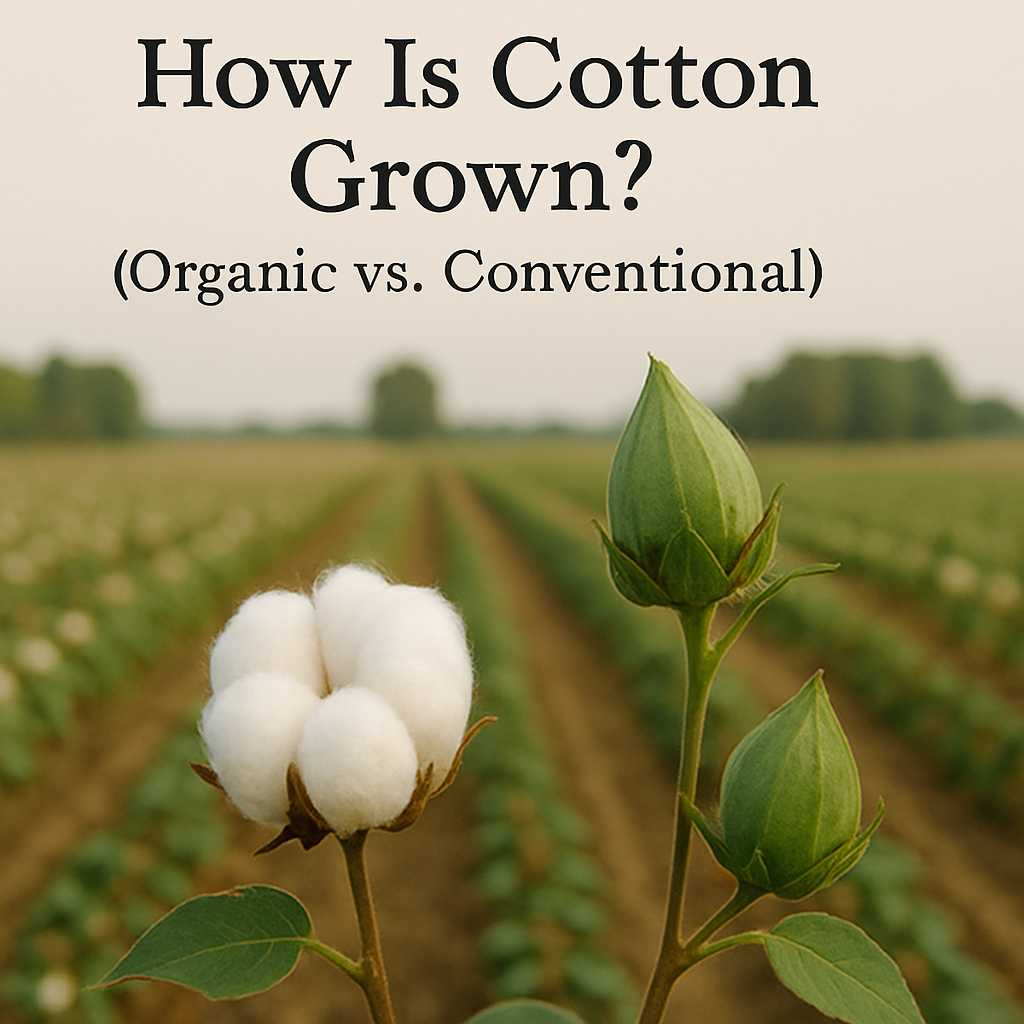
Conventional Cotton
Conventional cotton farming relies heavily on industrial methods that prioritize high yields but come with environmental trade-offs:
- Grown using synthetic fertilizers and chemical pesticides
- Often depends on genetically modified (GMO) seeds to resist pests and boost output
- Requires large amounts of water, leading to chemical runoff that can harm nearby ecosystems
Organic Cotton
Organic cotton is cultivated with sustainability and soil health in mind. It avoids harmful chemicals and supports natural growing cycles:
- Starts with non-GMO seeds
- Emphasizes crop rotation, composting, and natural pest control methods
- Often hand-picked in many regions to maintain fiber integrity
- Promotes biodiversity and nurtures healthier soil ecosystems
How Is Cotton Produced? (From Farm to Fabric)
The journey from cotton seed to soft fabric involves multiple stages, each one crucial in shaping the final product’s quality and sustainability. Let’s break down the process step by step.
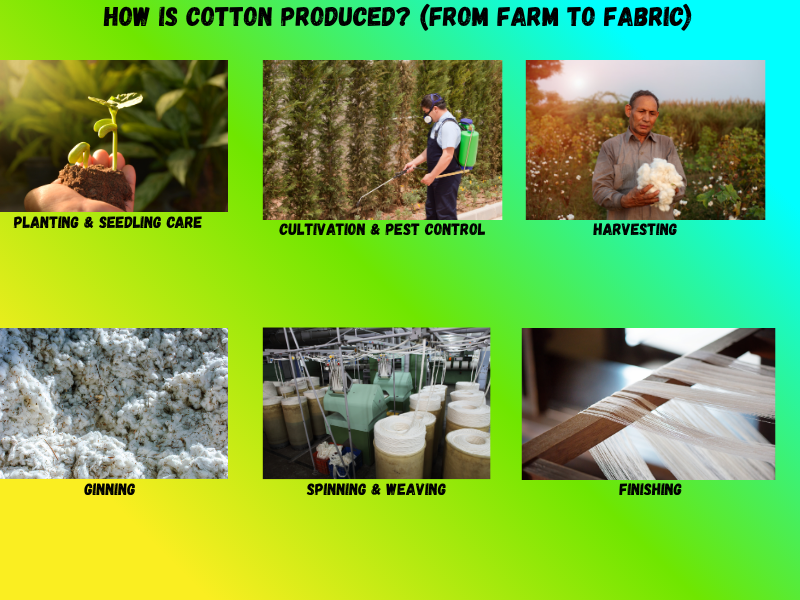
1. Planting & Seedling Care
Farmers plant cotton seeds and carefully nurture the seedlings as they grow.
2. Cultivation & Pest Control
Conventional cotton uses synthetic pesticides, while organic farming relies on natural methods like beneficial insects and crop rotation.
3. Harvesting
Cotton is harvested, often by hand in organic systems, to protect fiber purity and minimize damage.
4. Ginning
The cotton fibers (lint) are separated from seeds using a ginning machine.
5. Spinning & Weaving
Lint is spun into yarn and woven or knitted into fabric, forming the base of all cotton textiles.
6. Finishing
The fabric undergoes finishing processes like bleaching, dyeing, and printing.
In organic cotton production, finishing avoids harmful substances like azo dyes, formaldehyde, and heavy metals, ensuring a safer fabric for both people and the planet.
Where Is Organic Cotton Grown?
Organic cotton is grown in diverse regions around the world, from smallholder farms in East Africa to large-scale mechanized operations in the U.S. Below is a table of the leading producers, their contribution, and farming practices.
| Organic Cotton Production Share by Country (2022/23 Season)CountryOrganic Cotton Share of Global ProductionNotesIndia~38%World’s largest organic cotton producerTurkey~24%Strong growth in high-end textile marketsKyrgyzstan~9%High land share in organic farming in Central AsiaTanzania~6%Smallholder farms, often Fair Trade–certifiedUSA~2%Mechanized farms (e.g., Texas & New Mexico)Uganda~~1.9%Community-led production in East AfricaPeru~0.4%Niche production of naturally colored, traditional cotton |
|---|
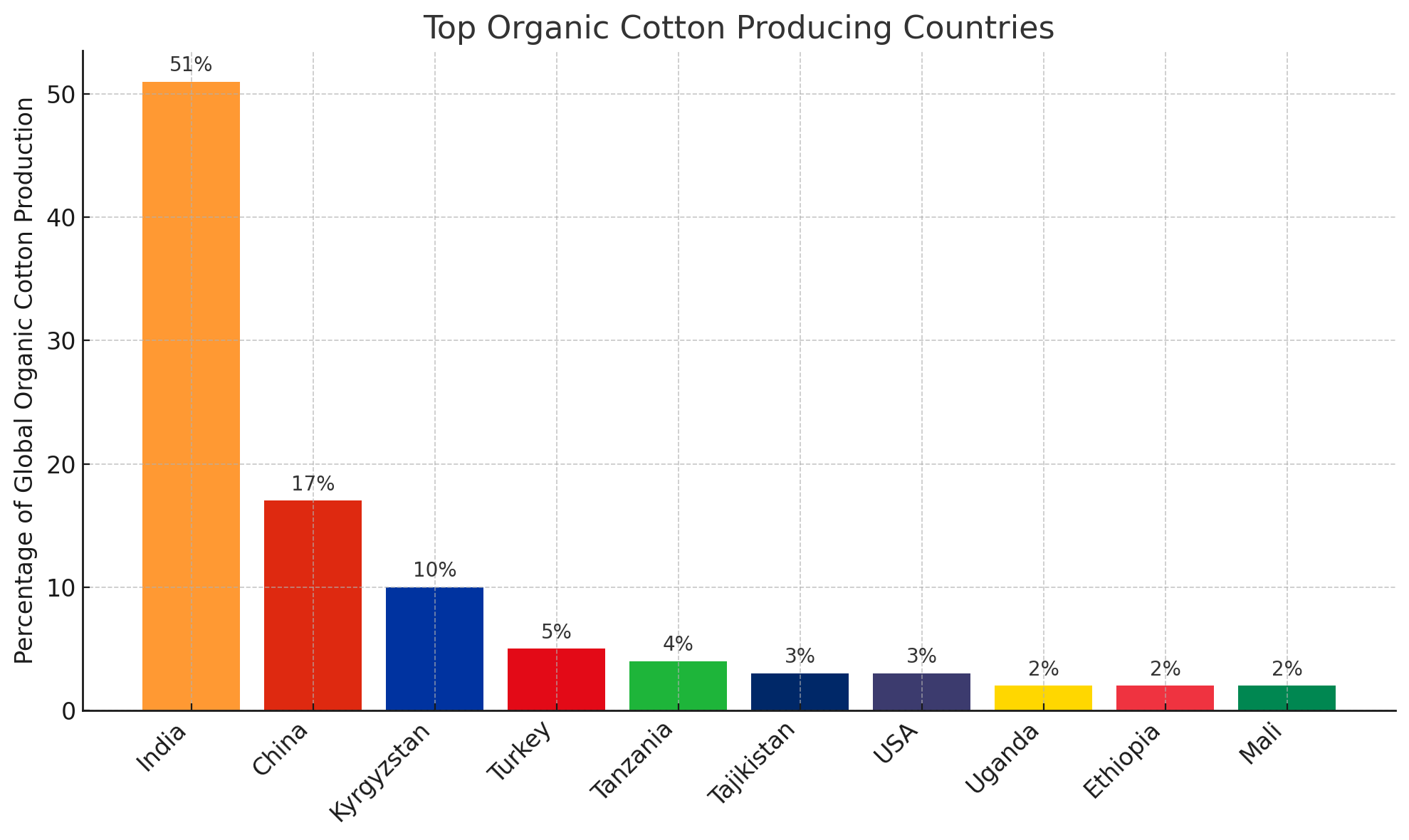
Benefits of Organic Natural Cotton Fabric
Organic natural cotton fabric offers a wide range of benefits, making it a preferred choice for individuals, families, and brands that prioritize health, sustainability, and ethical practices. Unlike conventionally grown cotton or synthetic fabrics, organic cotton delivers advantages at every stage—from production to end use.
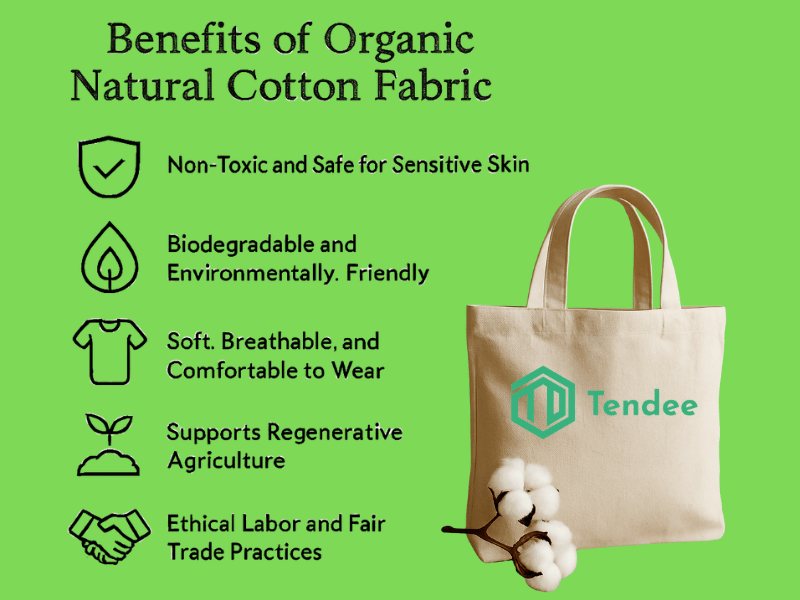
Non-Toxic and Safe for Sensitive Skin
One of the most important benefits of organic cotton is its non-toxic nature. It is grown without the use of synthetic pesticides, herbicides, or genetically modified organisms (GMOs), and processed without harsh chemicals like formaldehyde or heavy metals.
This makes it significantly safer for people with allergies, skin conditions, or chemical sensitivities. As a result, organic cotton is highly recommended for baby clothing, undergarments, sleepwear, and bedding, which come into close contact with delicate or sensitive skin.
Biodegradable and Environmentally Friendly
Organic cotton is a natural fiber that is fully biodegradable and compostable under the right conditions. Unlike synthetic fabrics such as polyester or nylon, which can take hundreds of years to break down and often release microplastics into the environment, organic cotton decomposes naturally without leaving behind toxic residues. This makes it an excellent choice for consumers who are committed to reducing landfill waste and embracing a more circular, sustainable lifestyle.
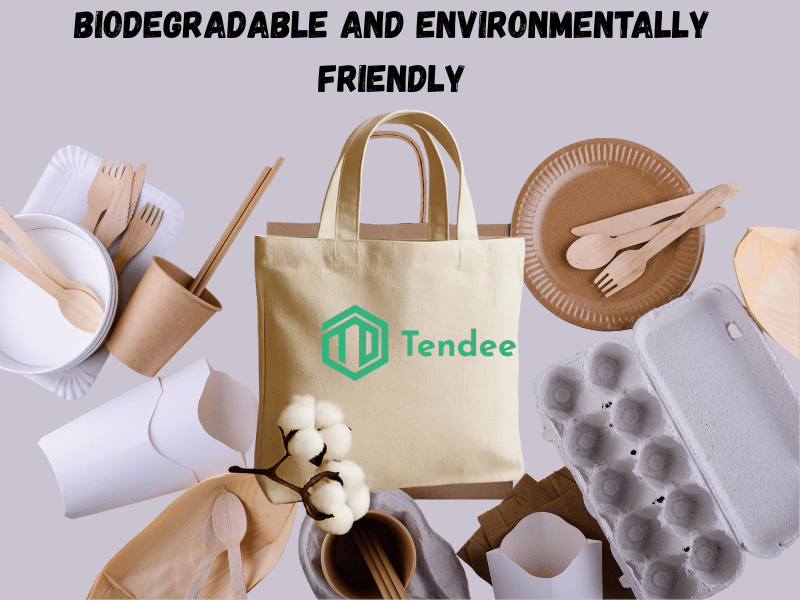
Soft, Breathable, and Comfortable to Wear
Many users find organic cotton to be softer and more breathable than its conventional counterparts. Because it is often hand-picked and processed with fewer chemicals, the fiber structure remains intact, resulting in a fabric that feels smoother against the skin. Organic cotton allows for better airflow, moisture-wicking, and temperature regulation, which enhances comfort, especially in warm or humid climates. It is an ideal fabric for daily wear, sportswear, and sleepwear.
Supports Regenerative Agriculture
Organic cotton farming promotes soil health, biodiversity, and water conservation. It avoids synthetic fertilizers and instead uses crop rotation, composting, and natural pest control to maintain a balanced and fertile ecosystem. These practices help build organic matter in the soil, improve water retention, and reduce erosion, key components of regenerative agriculture. By choosing organic cotton, consumers indirectly support farming systems that restore rather than deplete the environment.
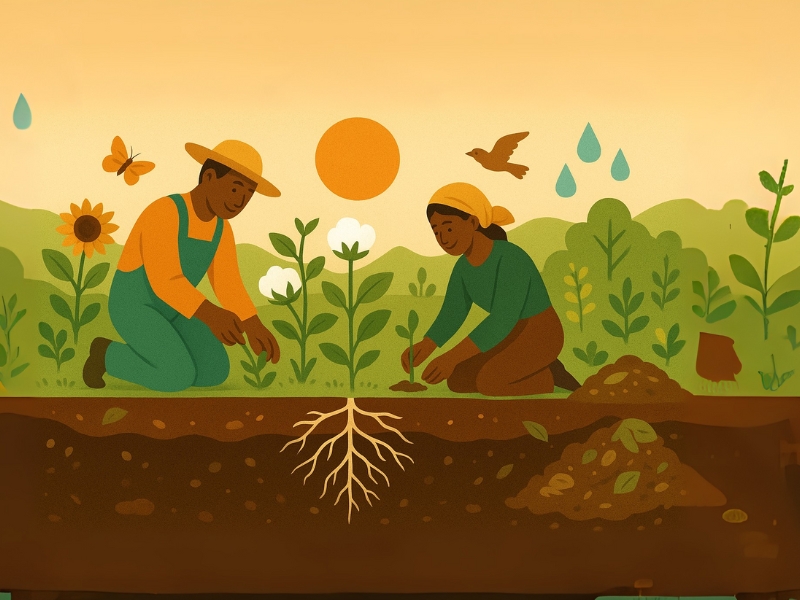
Ethical Labor and Fair Trade Practices
Many organic cotton certification programs also include strict social criteria. This often translates into better wages, safer working conditions, and support for smallholder farmers. Organic cotton production is commonly linked with initiatives that empower farming communities, especially in countries like India, Tanzania, and Uganda, where it provides a sustainable livelihood to thousands of families. Supporting organic cotton helps drive transparency and responsibility throughout the supply chain.
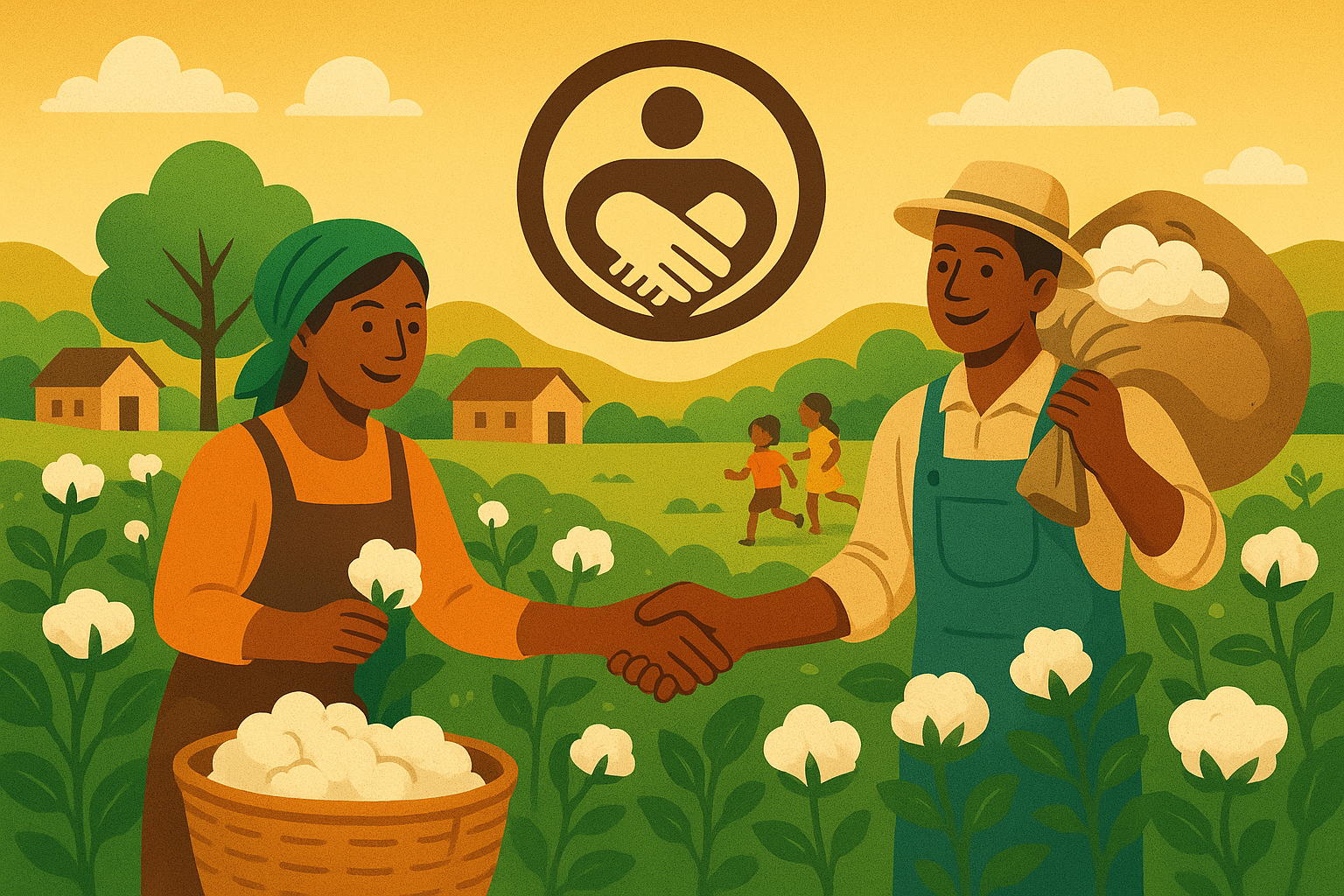
A Responsible Choice for Eco-Conscious Brands and Consumers
For environmentally aware brands and conscious consumers, organic cotton aligns with core values such as sustainability, ethical sourcing, and low environmental impact. It enables brands to meet increasing demand for eco-friendly products while maintaining quality and comfort. Consumers, in turn, can feel confident in their purchase decisions, knowing that the fabric they choose supports healthier ecosystems, humane labor conditions, and long-term sustainability.
Frequently Asked Questions
What’s the difference between organic and regular cotton?
Organic cotton is grown without synthetic pesticides, herbicides, or genetically modified seeds. It uses natural farming methods like crop rotation and composting to maintain soil health. Conventional cotton, on the other hand, often involves heavy chemical use and poses greater environmental and health risks during cultivation and processing.
Is “natural” cotton always organic?
No. The term “natural” is not regulated and can be misleading. Cotton labeled as “natural” may still be grown using conventional methods, including chemical fertilizers and pesticides. Only cotton certified by trusted bodies (like GOTS or USDA Organic) is guaranteed to meet organic standards from farm to finish.
How do I know if cotton is certified organic?
Look for labels or certifications such as GOTS (Global Organic Textile Standard), USDA Organic, or OEKO-TEX® Standard 100. These certifications ensure that the cotton has been grown and processed according to strict environmental and social criteria, including chemical restrictions, labor standards, and traceability.
Is organic cotton more sustainable than bamboo or hemp?
Each fiber has its sustainability profile. While bamboo and hemp are fast-growing and require less water, their processing can involve harsh chemicals unless specifically labeled as organic or eco-friendly. Organic cotton strikes a balance between familiarity, softness, and lower environmental impact, especially when it’s certified by reputable standards.
Why is organic cotton more expensive?
Organic farming avoids synthetic chemicals, which can lead to lower yields and higher labor costs due to practices like manual weeding and hand-picking. Additionally, certification and traceability processes add to production costs. However, the price reflects better environmental stewardship, safer working conditions, and a more transparent supply chain.
Conclusion
Organic cotton represents a more ethical, environmentally friendly future for textiles. It supports healthier ecosystems, safer working conditions, and products that are kinder to the skin and the planet. Whether you’re buying clothing, home goods, or packaging, choosing organic supports people, planet, and product quality.
Ready to make the switch to sustainable materials?
Explore Itendee’s range of GOTS-certified organic cotton tote bags and eco-friendly bags, where quality meets conscious living.

